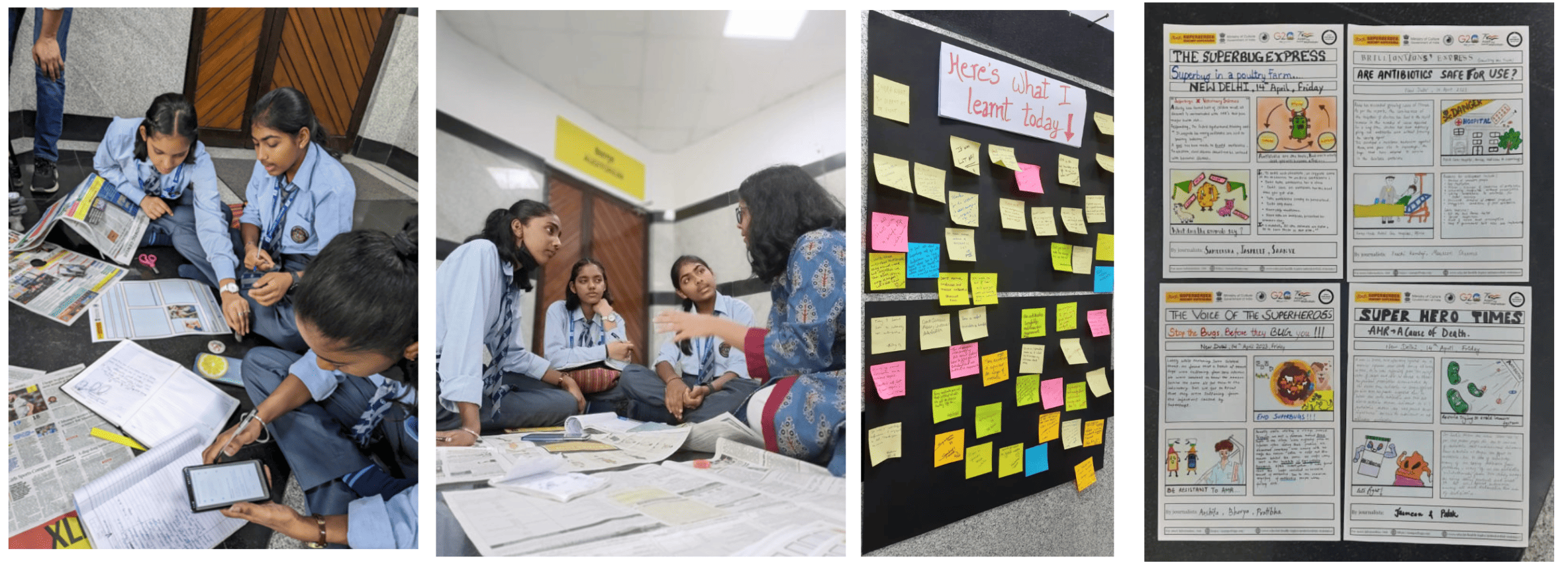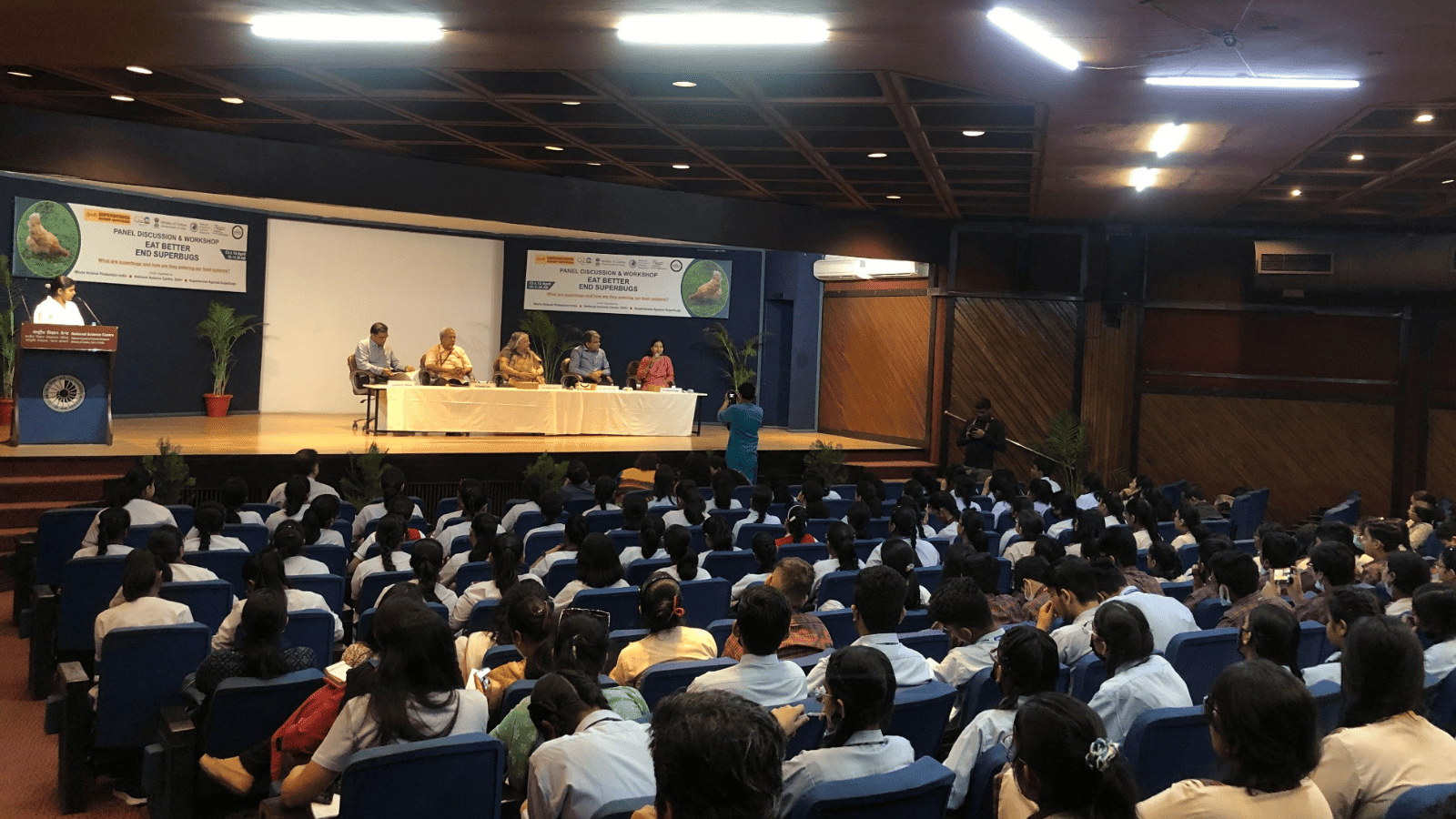Superheroes against Superbugs (SaS), in collaboration with World Animal Protection India and the National Science Center, New Delhi, hosted a two-day event ‘Eat Better – End Superbugs’ at the Centre on April 13th and 14th, 2023. The event was designed to inform and engage young people (14-16 years old) on the subject of Antimicrobial Resistance (AMR).

On the first day, a panel discussion was organised, which opened to a full house, buzzing with more than 300 students and other attendees eager to delve into the complex world of AMR. The panel was a diverse group consisting of Dr. Rajeshwari Sinha, microbiologist and policy researcher, Centre for Science and Environment; Dr. Vijay Pal Singh, veterinarian and consultant, WHO; Prof Sangeeta Sharma, educator and medical doctor, Institute of Human Behaviour and Allied Sciences, Delhi; Gajendra K. Sharma, Country Director, World Animal Protection India; and Mr. Ramdas Iyer, Director and museum curator, National Science Center India. Khushi Goel, a science communicator and undergraduate student at Delhi University, moderated the discussion.
The students actively participated in the discussion, asking probing questions that led to an engaging dialogue about the complex relationship between antibiotics, superbugs, and our food and environment. The speakers emphasised the issue of over the counter (OTC) availability of antibiotics (i.e., they can be purchased without a doctor’s prescription) and how a lack of knowledge about proper use of antibiotics in animal farming, agriculture, and human health settings leads to overconsumption, which is accelerating the formation of superbugs or AMR.
The conversation began with speakers demystifying terms such as antibiotics, antibiotic resistant bacteria, antimicrobial resistance (AMR) and superbugs. Dr. Singh and Dr. Sharma shone light on the diverse uses of antibiotics in animal farms and as medicines to cure diseases in humans. Adding to this, Dr. Sinha mentioned the use of a combination of two antibiotics – streptomycin and tetracycline, as pesticides in agriculture. The irresponsible use of antibiotics in these areas was highlighted through several examples.
Mr. Gajendra Sharma discussed the uses of antibiotics on animal farms, as well as how antibiotics enter our food chain through meat and dairy products. He also addressed a common misconception in the meat industry: antibiotics increase the rate and size of the animal. Mr Ramdas Iyer informed the audience about the numerous awareness programmes that NSC has hosted over the years to educate consumers about the potential harms of improper antibiotic use. The panel quoted a catchphrase for the audience, “Don’t Overuse, Underuse, Misuse Antibiotics,” and emphasised the adequate and responsible use of these drugs. After the event, the students continued with their questions for the speakers, which revealed their interest in and engagement with the topic.

The second day of the event saw a creative hands-on workshop where students took on the roles of news reporters and artists, creating illustrative news stories on AMR that also demonstrated their enriched understanding of the subject. This workshop, led by Khushi Goel, Shruti Sundaresan, and Sarah Hyder Iqbal, added a practical dimension to the theoretical insights presented on day one, allowing students to express their newfound knowledge creatively. The workshop also allowed the SaS team to discuss the nuances of AMR, clarify any misconceptions the students had, and discuss in more detail the real-world impacts of AMR on human and animal health and well-being. Along with the workshop, grassroots comics on various aspects of AMR created by young students at various SaS workshops were on display as an example of how storytelling can be used to make complex ideas accessible and relatable and to serve as inspiration for creative outputs developed by the participants.

The ‘Eat Better – End Superbugs’ event successfully combined expert insights from various fields with interactive, hands-on experiences to provide a comprehensive and engaging perspective on AMR to young people.
